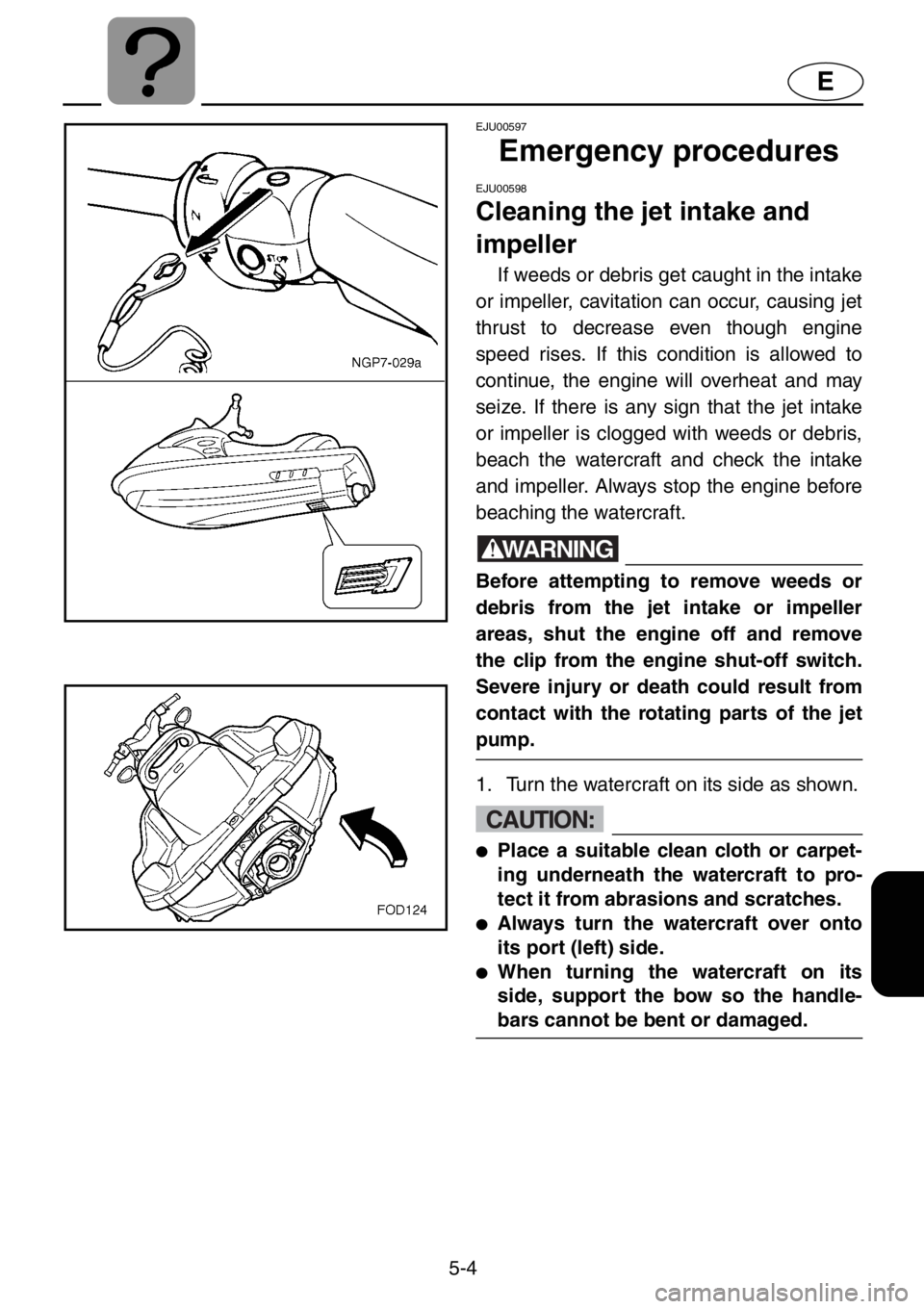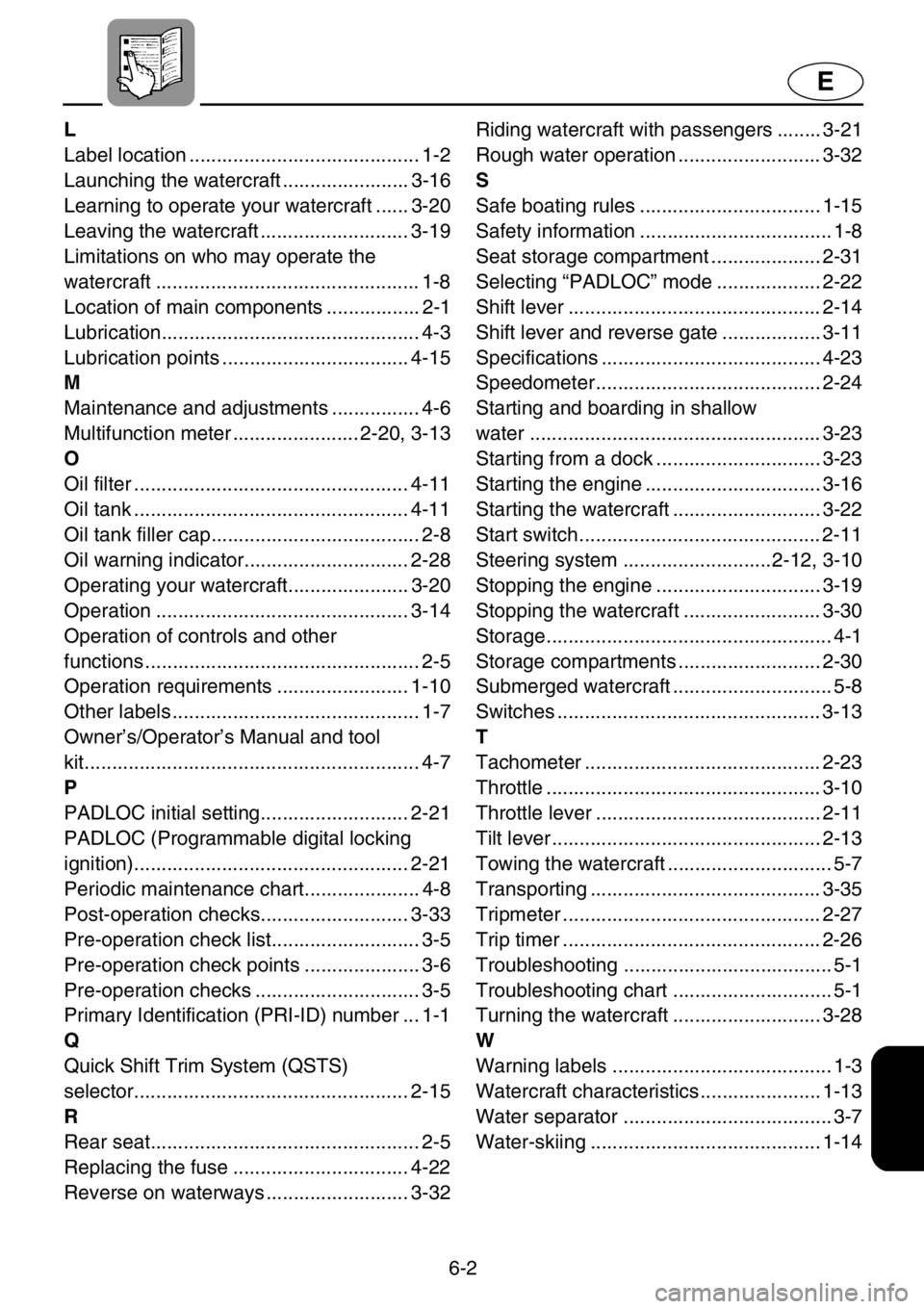check engine YAMAHA XL 1200 2001 Owner's Manual
[x] Cancel search | Manufacturer: YAMAHA, Model Year: 2001, Model line: XL 1200, Model: YAMAHA XL 1200 2001Pages: 131, PDF Size: 8.12 MB
Page 90 of 131

3-33
E
EJU00691a
Post-operation checks
Always perform the following post-opera-
tion checks after operating the watercraft.
1. Remove the watercraft from the water.
2. Wash down the hull, handlebars, and jet
unit with fresh water.
3. Remove the seat and check the engine
compartment for water. To drain excess
water, remove the stern drain plugs, then
raise the bow of the watercraft enough to
allow water in the bilge to drain out.
NOTE:
This watercraft is equipped with an auto-
matic bilge-draining system that removes
water from the engine compartment while
you are underway. However, some residual
water will remain.
4. Put the watercraft in a horizontal posi-
tion.
5. Flush the cooling system to prevent it
from clogging with salt, sand, or dirt.
(See page 4-1 for flushing the cooling
system procedures.)
6. Drain residual water from the exhaust
system by alternately squeezing and
releasing the throttle lever for 10 to
15 seconds while the engine is running.
CAUTION:
Do not attempt to run the engine at full
throttle or for more than 15 seconds
while the watercraft is out of the water,
otherwise the engine may overheat or
seize.
Page 118 of 131

5-1
E
EJU00595
Troubleshooting
If you have any trouble with your watercraft, use this section to check for the possible
cause.
If you cannot find the cause, or if the procedure for replacement or repair is not described
in this Owner’s/Operator’s Manual, have a Yamaha dealer perform the necessary service.
EJU00596a
Troubleshooting chart
TROUBLE POSSIBLE CAUSE REMEDY PAGE
Engine does not
startStarter motor does not turn over
Multifunction
meter“LOCK” mode selected Select “START” mode
2-22
Engine shut-
off switchClip not in place Install clip
2-10
Fuse Burned out Replace the fuse and
check wiring4-22
Battery Run down Recharge 4-20
Poor terminal connec-
tionsTighten as required
4-20
Terminal corroded Clean 4-4
Starter motor Faulty Have serviced by
Yamaha dealer—
Starter motor turns over
Fuel cock Turned to “OFF” Turn the fuel cock to
“ON”2-9
Fuel Empty Refill as soon as possi-
ble3-3
Stale or contaminated Have serviced by
Yamaha dealer4-10
Fuel tank Water or dirt present Have serviced by
Yamaha dealer4-10
Spark plug Fouled or defective Clean or replace 4-14
Spark plug cap Not connected or loose Connect properly 4-14
Crankcase Filled with water Crank engine with plug
out until clean5-8
Fuel filter Clogged or water
pooledHave serviced by
Yamaha dealer4-10
Choke Knob moves back on
its ownTighten the choke knob
adjusting nut4-18
Water
temperature
sensorFailed Have serviced by
Yamaha dealer —
Page 121 of 131

5-4
E
EJU00597
Emergency procedures
EJU00598
Cleaning the jet intake and
impeller
If weeds or debris get caught in the intake
or impeller, cavitation can occur, causing jet
thrust to decrease even though engine
speed rises. If this condition is allowed to
continue, the engine will overheat and may
seize. If there is any sign that the jet intake
or impeller is clogged with weeds or debris,
beach the watercraft and check the intake
and impeller. Always stop the engine before
beaching the watercraft.
WARNING
Before attempting to remove weeds or
debris from the jet intake or impeller
areas, shut the engine off and remove
the clip from the engine shut-off switch.
Severe injury or death could result from
contact with the rotating parts of the jet
pump.
1. Turn the watercraft on its side as shown.
CAUTION:
●Place a suitable clean cloth or carpet-
ing underneath the watercraft to pro-
tect it from abrasions and scratches.
●Always turn the watercraft over onto
its port (left) side.
●When turning the watercraft on its
side, support the bow so the handle-
bars cannot be bent or damaged.
Page 129 of 131

6-2
E
L
Label location .......................................... 1-2
Launching the watercraft ....................... 3-16
Learning to operate your watercraft ...... 3-20
Leaving the watercraft ........................... 3-19
Limitations on who may operate the
watercraft ................................................ 1-8
Location of main components ................. 2-1
Lubrication............................................... 4-3
Lubrication points .................................. 4-15
M
Maintenance and adjustments ................ 4-6
Multifunction meter ....................... 2-20, 3-13
O
Oil filter .................................................. 4-11
Oil tank .................................................. 4-11
Oil tank filler cap...................................... 2-8
Oil warning indicator.............................. 2-28
Operating your watercraft...................... 3-20
Operation .............................................. 3-14
Operation of controls and other
functions .................................................. 2-5
Operation requirements ........................ 1-10
Other labels ............................................. 1-7
Owner’s/Operator’s Manual and tool
kit............................................................. 4-7
P
PADLOC initial setting........................... 2-21
PADLOC (Programmable digital locking
ignition).................................................. 2-21
Periodic maintenance chart..................... 4-8
Post-operation checks........................... 3-33
Pre-operation check list........................... 3-5
Pre-operation check points ..................... 3-6
Pre-operation checks .............................. 3-5
Primary Identification (PRI-ID) number ... 1-1
Q
Quick Shift Trim System (QSTS)
selector.................................................. 2-15
R
Rear seat................................................. 2-5
Replacing the fuse ................................ 4-22
Reverse on waterways .......................... 3-32Riding watercraft with passengers ........ 3-21
Rough water operation .......................... 3-32
S
Safe boating rules ................................. 1-15
Safety information ................................... 1-8
Seat storage compartment .................... 2-31
Selecting “PADLOC” mode ................... 2-22
Shift lever .............................................. 2-14
Shift lever and reverse gate.................. 3-11
Specifications ........................................ 4-23
Speedometer......................................... 2-24
Starting and boarding in shallow
water ..................................................... 3-23
Starting from a dock .............................. 3-23
Starting the engine ................................ 3-16
Starting the watercraft ........................... 3-22
Start switch............................................ 2-11
Steering system ...........................2-12, 3-10
Stopping the engine .............................. 3-19
Stopping the watercraft ......................... 3-30
Storage.................................................... 4-1
Storage compartments .......................... 2-30
Submerged watercraft ............................. 5-8
Switches ................................................ 3-13
T
Tachometer ........................................... 2-23
Throttle .................................................. 3-10
Throttle lever ......................................... 2-11
Tilt lever ................................................. 2-13
Towing the watercraft .............................. 5-7
Transporting .......................................... 3-35
Tripmeter ............................................... 2-27
Trip timer ............................................... 2-26
Troubleshooting ...................................... 5-1
Troubleshooting chart ............................. 5-1
Turning the watercraft ........................... 3-28
W
Warning labels ........................................ 1-3
Watercraft characteristics ...................... 1-13
Water separator ...................................... 3-7
Water-skiing .......................................... 1-14